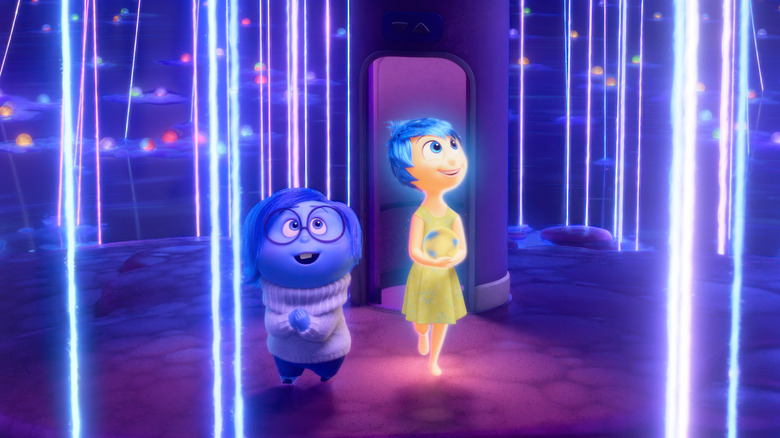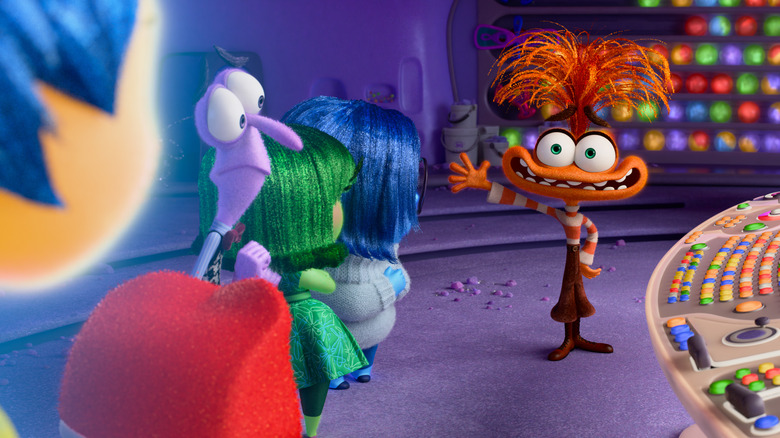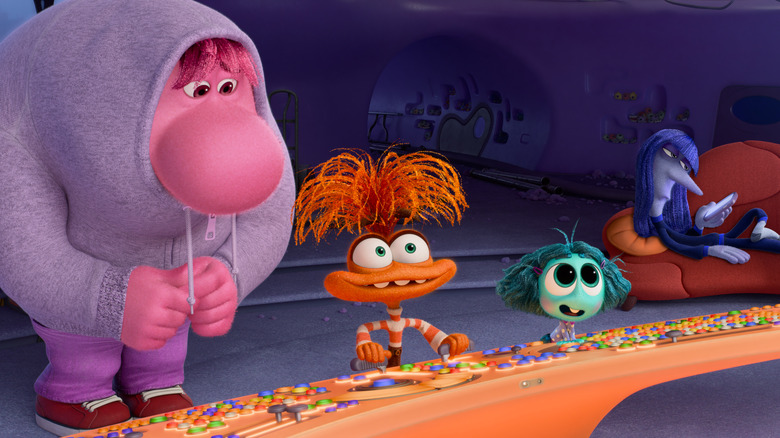Inside Out 2 Review: Pixar's Masterpiece Gets A Moving But Underdeveloped Sequel
- Expands upon Pixar's most brilliant premise
- Incredible depiction of anxiety
- Delivers both laughs and tears
- The human characters feel underwritten
- Can't go into enough depth with some of its big ideas
If I had a nickel for every time I reviewed a good-but-not-great 2024 sequel to a flat-out amazing 2015 film, I'd have two nickels, which isn't a lot, but it's weird that it's happened twice. "Furiosa: A Mad Max Saga" expanded upon "Mad Max: Fury Road" but couldn't hope to match its predecessor, and if there was any hope of "Inside Out 2" pulling off a "Toy Story 2"-level miracle, better to get your expectations in the "Incredibles 2"/"Monsters University" range — worthwhile family entertainment that hits the usual Pixar standard of quality animation and thoughtful storytelling, but not one of their instant classics.
Honestly, if you boil down the premise to "Pixar explores teen girls' emotional states," they already made the 10/10 version of "Inside Out 2" two years ago with "Turning Red" — a film that never quite got the celebration it deserved due to its Disney+ release and the, uh, let's say questionable online discourse that swarmed around it. But of course, there are many stories to tell about this subject matter, and "Inside Out 2" avoids feeling like the studio's repeating itself by addressing different concerns and digging more into the psychological mechanics that made the first movie so brilliant.
The thing with a premise and setting as great as "Inside Out" is that it always feels like it could go even deeper. As the internal life of Riley (Kensington Tallman) grows more complicated in the sequel, the more questions get raised, and for every perfect gag or spot-on observation, there's always some sort of missed opportunity. If Pixar's forced to move in a more sequel-heavy direction for the near future, the "Inside Out" series lends itself to further continuations because they can't run out of material here.
Big changes in Riley's brain
"Inside Out 2" opens with Riley in a hockey game, reintroducing all her emotions. While she's in the penalty box, Joy (Amy Poehler) catches us up on what happened between the first movie and the second — most importantly, the discovery of how Riley's belief system and sense of self get formed. This exposition isn't as elegant as the first movie's set up, and it feels like the ever-cautious Disney could never get away with really examining how beliefs form (every single one of Riley's "beliefs" onscreen is about her self-image as opposed to, like, politics or religion). But once these concepts get established, the movie can focus on what it's really interested in: how these things change in adolescence.
At first, puberty amplifies Riley's pre-existing emotions of Joy, Sadness (Phyllis Smith), Anger (Lewis Black), Fear (Tony Hale, replacing Bill Hader), and Disgust (Liza Lapira, replacing Mindy Kaling). Soon, new emotions enter headquarters: energetic Envy (Ayo Edobiri), couch potato Ennui (Adèle Exarchopoulos), shy Embarrassment (a near-silent Paul Walter Hauser), and the boss of this new crew, Anxiety (Maya Hawke). Anxiety shares the original emotions' intent to help out; where Fear tries to protect Riley from things she can see, Anxiety tries to protect her from things she can't. The difference is she's really bad at helping, destroying Riley's old sense of self and suppressing her predecessors in Riley's Vault of Secrets (the Vault sequence is a keeper, funniest stuff in the movie). During one scene where we see how Anxiety has rebuilt ImaginationLand, a young kid in my screening shouted, "I hate Anxiety!" Me too, kid.
While the old emotions traverse the pathways of Riley's mind on their quest to repair her sense of self and regain control of Headquarters, Riley herself is attending hockey camp. It might be her last chance to spend time with her old friends, who will be going to a different high school, but it's also her chance to try to make her favorite team and impress the cool older players. Compared to the richness of Riley's inner world, the characters in the outer world drama feel slightly underbaked — "Turning Red" did a much better job making its friendships feel real and lived-in. If those underbaked elements slightly blunt the emotional impact, Riley's relatable failures to navigate conflicting social priorities still offer some choice comedy — and some serious psychological tension.
A realistic panic attack
To really analyze where "Inside Out 2" both excels and falls short, we need to talk about the ending. While this review will avoid specifics, those sensitive to anything that may be considered a SPOILER should stop reading here.
So director Kelsey Mann and writers Meg LeFauve and Dave Holstein definitely saw all the hype around the "realistic panic attack" scene in "Puss in Boots: The Last Wish" and answered, "Hold our beers," right? When the animation team cites "Uncut Gems" as an inspiration, they're not being pretentious cinephiles — the climax of the movie really feels like THAT, albeit resolved with a classic Pixar happy-sad ending instead of a headshot.
Did I cry at the ending? Of course I did! That's pretty much the minimum requirement for a sequel to the movie that made us all say goodbye to Bing-Bong, and "Inside Out 2" clears that bar to justify itself as a worthy sequel. If it can't quite match the simple profundity of the first movie's "value of sadness" ending, the beliefs/self-image set-up here pays off for a similarly important and beautiful message. Considering the severity of how they depict Riley's anxiety, I wonder if there should have been a bit more to the resolution — again, all the internal action is expertly motivated and constructed, but perhaps more is needed in the external action.
Additionally, given the intensity of Riley's anxiety, I'd have also hoped for something more with long-term treatment and healing, akin to how "Steven Universe Future" addressed similar mental health concerns, though I also wonder if my own neurodivergence makes it hard to judge whether the ending will feel "too easy" for others or if it just feels "too easy" for me. Despite my questions and quibbles, I'm still happy this sequel exists, even if it falls short of masterpiece status.
"Inside Out 2" opens in theaters on June 14.


